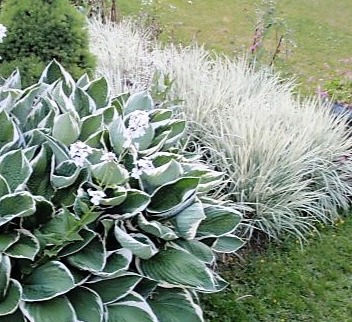This is the Time for the Grass to Grow and Glow
- vendiolaads
- Sep 8, 2022
- 3 min read
Updated: Oct 31, 2022
The long days of the tail end of summer -- late August to the first weeks of September -- are the tapering off of the blooming season in our gardens. The once pretty blooms of summer have started to be reduced into seed pods, or the gardeners have snipped them off to keep the garden presentable and to highlight whatever flowers are left struggling to carry on the summer flower parade.

As we observe the local water restrictions, even our lawns are turning brown and spotty. The garden plants' leaves show signs of drying spells and some even have withered altogether.
Yet you'll slowly notice that the new stars of the gardens are the ornamental grasses that not only bravely withstand the burning effect of long and intense summer sunshine and heat, but have valiantly spread out their plumes and wiry seed heads.
No longer just for the lawn -- gardeners have been using grasses in the gardens as well -- grasses take centerstage over time. With their various heights, sizes, colors, and looks, grasses can be used in a garden to add those very qualities. And more.

Grasses are very hardy. They are simply “stronger” than the stems of nearly all flowering perennials. Grasses are less likely to snap off in strong winds or collapse in a soggy heap after a storm. They dance with the wind, bending instead of breaking.
In fact, the gracefulness of grasses when blown by the wind makes them more desirable to gardeners who want added dimensions to the garden: movement and sound.
Grasses also work well with light. There is a magical time when the sun is low in the sky (like in the early morning and when the sun is about to set) when grasses get backlit. You notice the beautiful colors of the stems of tall grasses and the cloud-like, shimmering appearance of their plumes or seed heads when “spotlighted” from the back.
Our garden mainly runs parallel to two intersecting streets. Neighbors walking by or driving to work in the morning have the joy of seeing the swaying grass backlit by the rising sun. In the late afternoon, neighbors walking by or driving home can see the other side of the garden with the grasses beautifully backlit by the setting sun. (A neighbor even uses low-wattage colored LED spotlights to get similar effects at night on her grasses.) And if neighbors walk by our garden and a strong breeze is working, they could hear the soft rustling and see the synchronized swaying of the grasses.
Feathery ornamental grasses are versatile plants in any landscape that can provide all-seasons interest. Many kinds of grass create swaths of colorful blades and equally colorful airy or diffused seed heads. Thus, grasses contrast very well with other plants, by juxtaposing them with perennials with contrasting or complementary colors or forms.
The airiness of grasses makes them very attractive neighbors to solid-looking conifers and rounded shrubs like our favorite dwarf Japanese weeping maple trees.
Also, grasses are excellent as featured plants in ornamental pots.
For those who have no yard or enough space for a real garden, potted plants are great alternatives. You'll notice such pots look awesome when grass is incorporated into the ornamental pot. The grass can provide the height, the unexpected twist, the illusion of movement, the dramatic texture, or the draping, blousey look.
Grasses can even hold their own as a single specimen or a featured plant in pots. Such types of grass include pampas grass, zebra grass, phormiums or New Zealand phlox, Mexican feather grass, and dwarf bamboo (most bamboos are the world's tallest grass).

Planted en masse, any grass variety can umph its wow factor. A daintily leafed variety, for example, gains visual weight, creating an expanse that looks very unified, pleasing, and calming.
Almost all grasses gain prominence this way, although those with very structural, colorfully patterned blades or leaves can hold their own beauty even when planted as a specimen plant like in ornamental pots or surrounded by a large grassy lawn. Phormiums (New Zealand flax) and pampas grass fall in this category.
Grasses have a grand architectural presence, though simple in form. In most cases, they are tufted mounds of basal blades as leaves, slender upright but bendable stems, and crowns of airy clusters of “flowers.” Their crown of airy florets that mature into attractive seed heads create a dynamic sense of movement and even look like little wands, waving and weaving magic in our garden. This can be further heightened by backlighting (natural or electric). Grasses are also ideal for mass planting, creating bold solitary features, or simply punctuating a mixed perennial border. Grasses can be perfect as specimen plants in pots. Indeed, grasses have come a long way from merely the green stuff that makes our lawns attractive -- we enjoin you to bring grasses into your gardens.

Comments